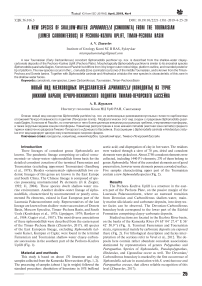A new species of shallow-water Siphonodella (conodonta) from the tournaisian (lower carboniferous) of Pechora-Kozhva uplift, Timan-Pechora basin
Автор: Zhuravlev A.V.
Журнал: Вестник геонаук @vestnik-geo
Рубрика: Научные статьи
Статья в выпуске: 4 (292), 2019 года.
Бесплатный доступ
A new Tournaisian (Early Carboniferous) conodont Siphonodella puchkovi sp. nov. is described from the shallow-water clayey-carbonate deposits of the Pechora-Kozhva Uplift (Pechora Plate). Morphologically Siphonodella puchkovi is similar to its ancestral species Siphonodella quasinuda Gagiev, Kononova et Pazuhin but differs from it by longer outer rostral ridge, platform outline, and rounded posterior tip of platform. The new species occurs in the L . crenulata Zone ( carinata local zone) of the middle Tournaisian, and is known from the Timan-Pechora and Donets basins. Together with Siphonodella carinata and Hindeodus cristulus the new species is characteristic of this zone in the shallow-water facies.
Conodonts, new species, lower carboniferous, tournaisian, timan-pechora basin
Короткий адрес: https://sciup.org/149129370
IDR: 149129370 | УДК: 56.016.3 | DOI: 10.19110/2221-1381-2019-4-25-28
Текст научной статьи A new species of shallow-water Siphonodella (conodonta) from the tournaisian (lower carboniferous) of Pechora-Kozhva uplift, Timan-Pechora basin
Three lineages of conodont genus Siphonodella are known. The pandemic lineage comprising so-called «orna-mented» or «deep-water» siphonodellids forms basis for the detailed conodont zonation of the terminal Famennian and Tournaisian (excluding uppermost Tournaisian) (Sandberg et al., 1978). Besides «ornamented» siphonodellids two endemic lineages of this genus are known in the East Europe and South China. The Chinese lineage is composed of species possessing unornamented Pa elements (Ji & Ziegler, 1992; Ji, 2004). These species dwelt shallow-water marine environment. Another shallow-water lineage of sipho-nodellids, characterized by unornamented or poorly ornamented Pa elements, existed in East European part of the Laurussia Palaeocontinent only. Representatives of the last lineage are known from shallow-water successions of Donets Basin, Moscow Syneclise, Timan-Pechora Basin, and South Urals (Kozitskaya et al., 1978; Lipnjagov, 1979; Barskov et al., 1984; Gagiev et al., 1987). The most diverse associations of these siphonodellids were described from the eastern part of the Timan-Pechora Basin (Zhuravlev, 2017). All species of the East European lineage, excluding Siphonodella kal-vodai Kaiser, Kumpan et Cigler, were found in the terminal Famennian and Tournaisian shallow-water clayey-carbonate successions in the southern part of the Pechora-Kozhva Uplift (Fig. 1).
Material and methods
This study is based on about 170 limestone and clay samples collected from the Kamenka River sections (Figs. 1, 2). The processing of samples (about 1 kg in weight) followed the standard procedure: dissolution of limestone in 10% buffered acetic acid; and dispergation of clay in hot water. The residues were washed through a sieve of 70 μm, dried and conodont elements were picked out. About 2750 conodont elements were collected, including 1440 P1-elements; 270 of them belong to genus Siphonodella. Most of the conodont elements are of good preservation, however some elements possess corroded surface. Five samples characterizing upper part of the Tournaisian contain a new Siphonodella species (Fig. 2).
Results
The Pechora-Kozhva Uplift is a structure in the eastern part of the Pechora Plate, on the passive margin of the Laurussia Palaeocontinent, where an eastward transition from Devonian and Carboniferous shallow-water, mainly marine siliciclastic and carbonate deposits, into deep water facies can be observed. The Devonian-Carboniferous boundary beds correspond to the lower part of the Edzhid Formation comprising clayey-carbonate deposits.
Studied sections are located in the Kozhva River basin, on the banks of the Kamenka River (N 65° 04’ 27.4’’ E 56° 42’ 50.9’’) (Fig. 1). Terminal Famennian and Tournaisian strata, represented mainly by carbonate deposits are exposed there (Fig. 2). For lithological description and facies interpretation of the sections refer to Vevel et al., 2012. The deposits here contain rather abundant conodont associations dominated by representatives of genera Polygnathus and Patrognathus . Species of Siphonodella , Pseudopolygnathus , Hindeodus , and Ligonodina occur as well. The Devonian/ Carboniferous boundary is marked by the first occurrence of Siphonodella sulcata in association with S. semichatovae and Patrognathus crassus , that allows reliable recognition of this level (Zhuravlev, 2017).
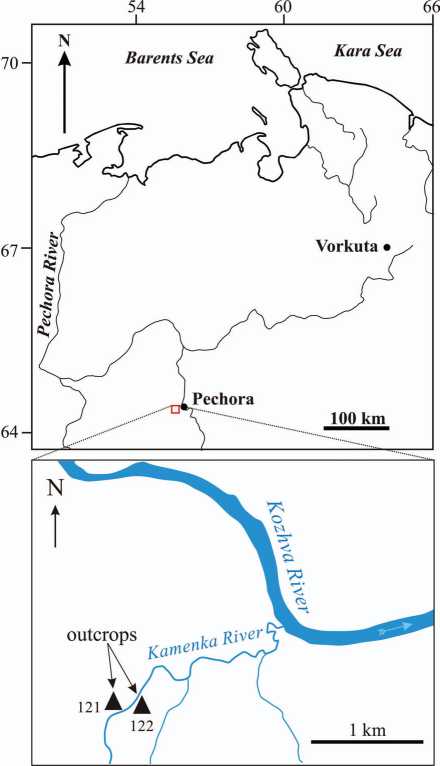
Fig. 1. Locality schematic maps. Triangles mark outcrops
Ðèñ. 1. Ñõåìàòè÷åñêèå êàðòû ðàñïîëîæåíèÿ ðàçðåçîâ. Îáíà-æåíèÿ îòìå÷åíû òðåóãîëüíèêàìè
Occurrence of a diverse shallow-water assemblage of siphonodellids, including Siphonodella bella Kononova et Migdisova, S. quasinuda Gagiev, Kononova et Pazuhin, S. semichatovae Kononova et Lipnjagov, S. ludmilae Zhuravlev et Plotitsyn, and S. carinata Zhuravlev, allowed to reveal their phylogeny and to propose local conodont zones (Zhuravlev, 2017). Studied siphonodellids demonstrate wide morphological variation in their platform outline and ornamentation, including rostrum architecture, that allows to recognize a new species – Siphonodella puchkovi sp. nov. (Fig. 3). This species is represented by few specimens only and was mentioned as S . aff. quasinuda earlier (Zhuravlev, 2017).
Systematic paleontology
Genus Siphonodella Branson et Mehl
Siphonodella puchkovi sp. nov.
Fig. 3.1–3.3
Siphonodella aff. crenulata : Kozitskaya et al., 1978, p. 88-89, pl. VI, fig. 7
Siphonodella sp. A: Lipnjagov, 1979, Pl. 2, fig. 2
Etymology : In honor of V.V. Puchkov, for his contribution to conodont studies in the North Urals.
Holotype : Fig. 3.1, specimen 703/16, sample 121-15/18, Kamenka River section, Pechora Swell, Timan-Pechora Basin, Lower crenulata Zone ( carinata local zone).
Paratype : Fig. 3.2, specimen 687/36, sample 1221-9/91, Kamenka River section, Pechora swell, Timan-Pechora basin, Lower crenulata Zone ( carinata local zone).
Diagnosis : Advanced siphonodellid species with P1 ele-
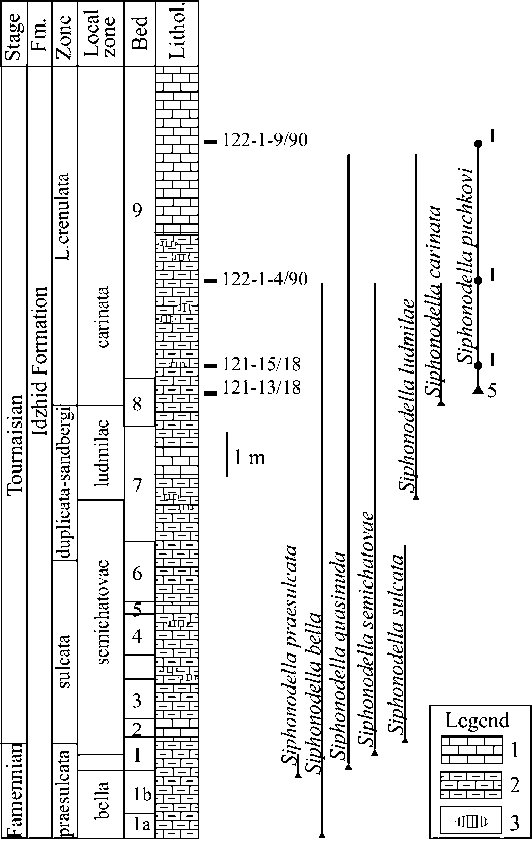
Fig. 2. Composite log of the Kamenka River section demonstrating first occurrence datums (triangles) and ranges of the siphonodel-lids species. Legend: 1 — limestones; 2 — clayey limestones and thin alternation of limestone and clay; 3 — cherty concretions; 4 — conodont samples; 5 — conodont samples containing Siphonodella puchkovi sp. nov.
Ðèñ. 2. Ñâîäíàÿ êîëîíêà ðàçðåçà íà ð. Êàìåíêå, äåìîíñòðè-ðóþùàÿ óðîâíè ïåðâûõ íàõîäîê (òðåóãîëüíèêè) è èíòåðâàëû ðàñïðîñòðàíåíèÿ âèäîâ ðîäà Siphonodella . Óñëîâíûå îáîçíà-÷åíèÿ: 1 — èçâåñòíÿêè; 2 — ãëèíèñòûå èçâåñòíÿêè è òîíêîå ÷åðåäîâàíèå èçâåñòíÿêîâ è ãëèí; 3 — êðåìíèñòûå êîíêðå-öèè; 4 — îáðàçöû íà êîíîäîíòû; 5 — îáðàçöû, ñîäåðæàùèå Siphonodella puchkovi sp. nov.
ments having lanceolate, smooth, and asymmetric platform with prominent rostrum that bears up to two rostral ridges. Long outer rostral ridge merges with the lateral platform margin. The inner rostral ridge is short.
Description : P1-elements possessing lanceolate asymmetric platform with rounded posterior tip. Prominent rostrum bears up to two rostral ridges. The outer rostral ridge is long and merges with the lateral platform margin. Short inner rostral ridge is gently bent towards the lateral platform margin. The elements possess features characteristic of Class II symmetry sensu Lane (1968). Platform ornamentation is poor or absent. Inner part of platform is smooth or bears scattered nodes or unclear ribs. Outer part of platform may be ornamented bearing wide and low transverse ribs. Carina sigmoidal, strongly bowing inwards and decreasing in height posteriorly. Keel is thin in the anterior part and depressed in the posterior part of the element that is similar to other ad-
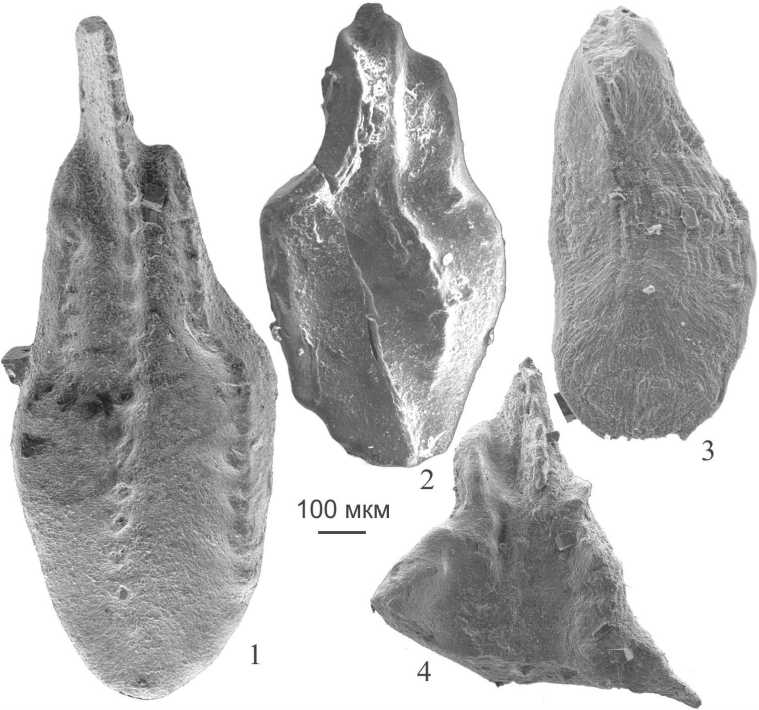
Fig. 3. P1-elements of Siphonodella puchkovi sp. nov. from the Tournaisian Lower crenulata Zone ( carinata local zone) of the Kamenka River section: 1 — upper view of dextral element, speci-men703/16 (holotype), outcrop 121, sample 121-15/18; 2 — upper view of sinistral element, specimen 687/36, outcrop 122, sample 122-1-9/91; 3 — lower view of sinistral element, specimen 704/1, outcrop 121, sample 121-13/18 (P1 element of Siphonodella aff . puchkovi sp. nov. comes from the same locality and stratum); 4 — upper view of anterior part of gerontic sinistral element, specimen 703/14, outcrop 121, sample 121-13/18
Рис. 3. P1-элементы Siphonodella puchkovi sp. nov. из турней-ской зоны нижней crenulata (местная зона carinata ) в разрезе на р. Каменка: 1 — вид сверху правого элемента, экз. 703/16 (голотип), обн. 121, обр. 121-15/18; 2 вид сверху левого элемента, экз. 687/36, обн. 122, обр. 122-1-9/91; 3 — вид снизу левого элемента, экз. 704/1, обн. 121, обр. 121-13/18 (Р1-эле-мент Siphonodella aff . puchkovi sp. nov. из того же местонахождения и стратиграфического интервала); 4 — вид сверху передней части геронтического левого элемента, экз. 703/14, обн. 121, обр. 121-13/18
vanced siphonodellids in the East-European lineage. Small basal pit is located in the mid-point of the element.
Cross-section asymmetry of denticles on the free blade (Fig. 4A) suggests arrangement of P1 elements in the apparatus where sinistral one of them is located somewhat posteriorly of the dextral element (Fig. 4B). It is supposed that rostral ridges, free blade, and anterior carina were closely occluded whereas posterior carina and platform were occluded in a lesser degree (Fig. 4B).
Remarks : Siphonodella puchkovi sp. nov. is closely related to other species of the advanced shallow-water siphonodellids, such as S. ludmilae Zhuravlev et Plotitsyn, S. kal-vodai Kaiser, Kumpan et Cigler, and late forms of S. quasi-nuda Gagiev, Kononova et Pazuhin. It differs from S. kalvo-dai by smoother platform outline, longer outer rostral ridge, by having only two rostral ridges at the late stage of ontogeny, and by Class II symmetry. S. puchkovi differs from S. ludmilae by having smooth or poorly ornamented platform and smoother outer outline of platform. From the morphologically close to it species, S. quasinuda , S. puchkovi differs by possessing longer outer rostral ridge, by general platform outline (lanceolate and strongly asymmetric), and by rounded posterior tip of platform.
Material : 9 specimens from the Middle Tournaisian ( L. crenulata Zone or carinata local zone) of the Kamenka River section, Pechora Swell, Timan-Pechora Basin.
Distribution : Lower Carboniferous, Tournaisian (L . crenulata Zone) of the Timan-Pechora and. Donets basins (East European Platform).
Figured specimens are deposited in the Geological Museum of Institute of Geology Komi SC UB RAS, Syktyvkar, collections #703, 704, and 687.
Concluding remarks
According to the data obtained, Siphonodella puchkovi probably evolved from S. quasinuda by the development of a longer outer rostral ridge. The first occurrence datum (FOD) of S. puchkovi in the Timan-Pechora Basin approximately
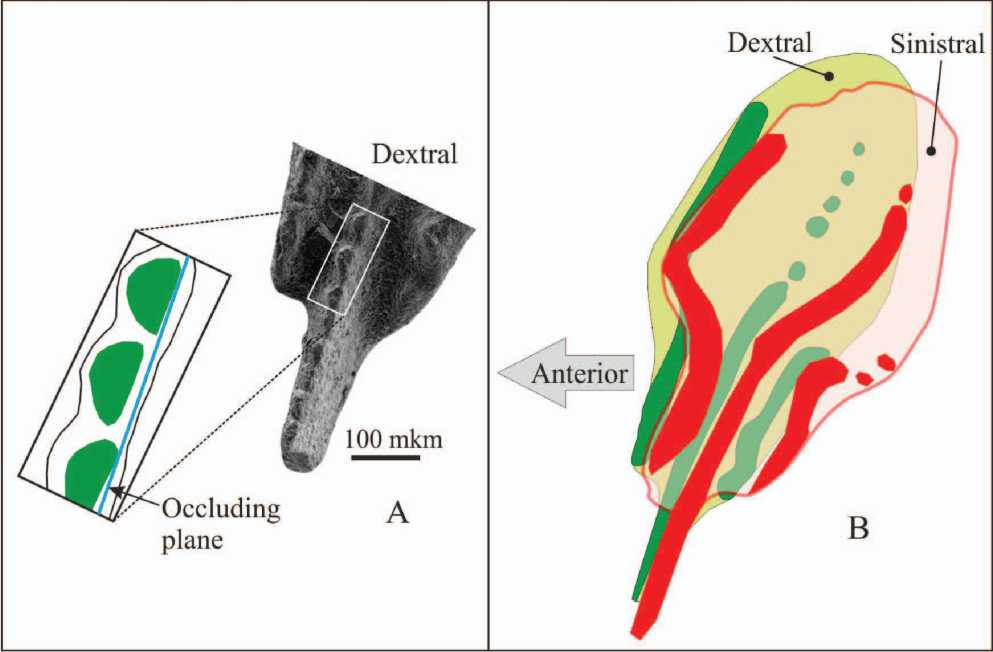
Fig. 4. Scheme of occlusion of P1-elements of Siphonodella puchkovi sp. nov. A — close-up view of free blade of the dextral P1 element demonstrating asymmetry of the cross sections of denticles providing occlusion along the inner surface of free blade; B — schematic drawing of occluding P1-elements (dextral in green, sinistral in red)
Рис. 4. Схема смыкания P1-элементов Siphonodella puchkovi sp. nov. A — увеличенное изображение свободного листа правого P1-элемента, демонстрирующее асимметрию поперечного сечения зубцов, которая обеспечивала смыкание вдоль внутренней поверхности свободного листа; B — схематический рисунок смыкания P1-элементов (правый — зеленый, левый — красный)
corresponds to lower part of the Lower crenulata Zone ( cari-nata local zone). In the Donets Basin this species was reported from the middle part of the C1tb Formation, in association with Hindeodus crassidentatus (Branson et Mehl), H. penescitulus Rexroad et Collinson, Bispathodus aculea-tus (Branson et Mehl), Patrognathus andersoni Klapper, Pseudopolygnathus dentilineatus Branson, Ps. multistria-tus Mehl et Thomas, Siphonodella semichatovae Kononova et Lipnjagov, S. aff. sulcata (Huddle), Polygnathus parape-tus Druce, Pol. stylensis Lipnjagov, Pol. inornatus Branson, Pol. longiposticus Branson et Mehl (Kozitskaya et al., 1978). This association suggests correlation with the Lower crenu-lata Zone. Thus S. puchkovi ranges in the Lower crenulata Zone of the Tournaisian. In association with S. carinata and H. cristulus the new species marks this zone in the shallowwater facies.
Acknowledgements . Anonymous reviewers are thanked for their comments, detailed remarks, and corrections of the manuscript.
Список литературы A new species of shallow-water Siphonodella (conodonta) from the tournaisian (lower carboniferous) of Pechora-Kozhva uplift, Timan-Pechora basin
- Барсков И. С., Кононова Л. И., Мигдисова Н. С. Конодонты нижнетурнейских отложений Подмосковного бассейна / Ред. В. В. Меннер // Палеонтологическая характеристика стратотипических и опорных разрезов карбона Московской синеклизы. М.: Изд. МГУ, 1984. С. 3-33.
- Гагиев М. Х., Кононова Л. С., Пазухин В. Н. Конодонты / Ред. В. А. Маслов // Фауна и биостратиграфия пограничных отложений девона и карбона Берчогура (Мугоджары). М.: Наука, 1987. С. 91-97.
- Ji Q. Study on the phylogeny, taxonomy, zonation and biofacies of Siphonodella (Conodonta) // Bulletin of the Institute of Geology Chinese Academy of Geological Sciences. 1985. 11. P. 51-78.
- Ji Q. 2004. On the change of conodonts near the Devonian-Carboniferous boundary // Professional Papers of Stratigraphy and Palaeontology. Geology Publish House, Beijing, 2004. P. 111-123.
- Ji Q. & Ziegler W. Phylogeny, speciation and zonation of Siphonodella of shallow water facies (Conodonta, Early Carboniferous) // Courier Forschungsinstitut Senckenberg. 1992. 154. P. 223-251.

